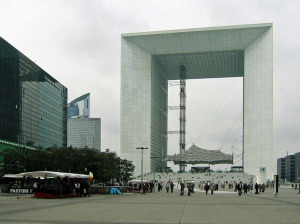The Champs-Élysées follows the “Historic Axis” or “Triumphal Way,” an imaginary line passing through the Louvre¸ the Place de la Concorde and the Arc de Triomphe. After World War II, Parisian city planners decided to try to preserve the traditional appearance along the Historic Axis by encouraging new construction in La Défense, a five square mile area several kilometers northwest of the Arc de Triomphe. When the Tour Montparnasse, a 59-story skyscraper now deemed the second ugliest building in the world, was completed in the Left Bank area in 1973, Parisians were so incensed they passed a law requiring that buildings taller than seven stories be limited to La Défense, named for a statue honoring French soldiers.
Restricting tall buildings to La Défense did not solve the problem to the satisfaction of all Parisians. The incongruous collection of glass and steel buildings could still be seen from atop the Arc de Triomphe. The solution involved building a massive Grand Arche at the center of La Défense, positioned on the Historic Axis and connoting continuity with Parisian history. The Grande Arche was also situated on the imaginary axis that runs through the Eiffel Tower from the infamous Tour Montparnasse. The Grande Arche, which is actually an office building, is 361 feet tall, 348 feet wide and 364 deep and includes an opening said to be large enough to accommodate Notre Dame Cathedral.
La Défense, once home to small restaurants and artists’ studios, has become one of the most important business centers in the world. More than 70 modern buildings, up to 50 stories high, house 1500 corporate headquarters, including those of 15 of the world’s 50 largest companies. Each year, about eight million tourists come to La Défense. The sixty million other visitors to Paris can pretend it doesn’t exist.

Comments are closed.